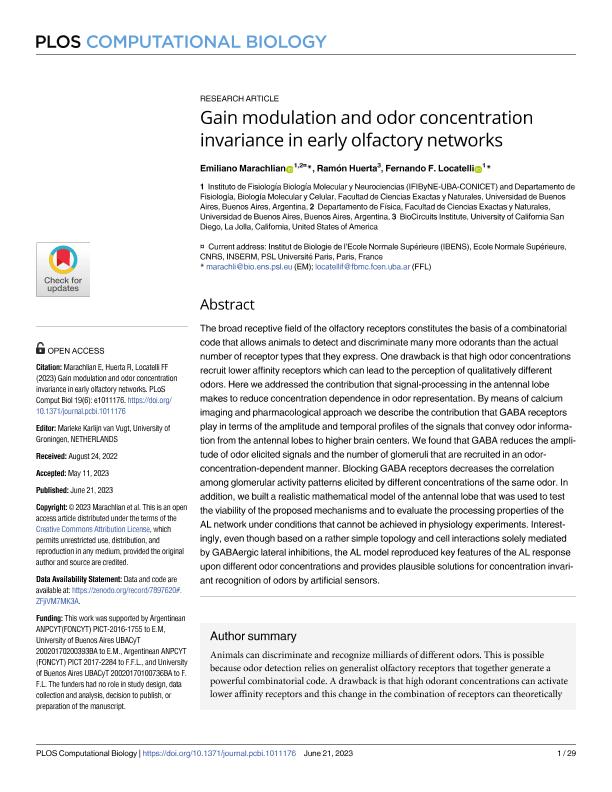Mostrar el registro sencillo del ítem
dc.contributor.author
Marachlian, Emiliano

dc.contributor.author
Huerta, Ramon
dc.contributor.author
Locatelli, Fernando Federico

dc.date.available
2024-04-12T12:31:18Z
dc.date.issued
2023-05
dc.identifier.citation
Marachlian, Emiliano; Huerta, Ramon ; Locatelli, Fernando Federico; Gain modulation and odor concentration invariance in early olfactory networks; Public Library of Science; Plos Computational Biology; 19; 5-2023; 1-29
dc.identifier.issn
1553-734X
dc.identifier.uri
http://hdl.handle.net/11336/232865
dc.description.abstract
The broad receptive field of the olfactory receptorsconstitutes the basis of a combinatorial code that allows animals to detect anddiscriminate many more odorants than the actual number of receptor types thatthey express. One drawback is that high odor concentrations recruit loweraffinity receptors which can lead to the perception of qualitatively differentodors. Here we addressed the contribution thatsignal-processing in the antennal lobe makes to reduce concentration dependencein odor representation. By means of calcium imaging and pharmacologicalapproach we describe the contribution that GABA receptors play in terms of theamplitude and temporal profiles of the signals that convey odor informationfrom the antennal lobes to higher brain centers. We found that GABA reduces theamplitude of odor elicited signals and the number of glomeruli that are recruitedin an odor-concentration-dependent manner. Blocking GABA receptors decreasesthe correlation among glomerular activity patterns elicited by differentconcentrations of the same odor. In addition, we built a realistic mathematicalmodel of the antennal lobe that was used to test the viability of the proposedmechanisms and to evaluate the processing properties of the AL network underconditions that cannot be achieved in physiology experiments. Interestingly,even though based on a rather simple topology and cell interactions solelymediated by GABAergic lateral inhibitions, the AL model reproduced key featuresof the AL response upon different odor concentrations and provides plausiblesolutions for concentration invariant recognition of odors by artificialsensors.
dc.format
application/pdf
dc.language.iso
eng
dc.publisher
Public Library of Science

dc.rights
info:eu-repo/semantics/openAccess
dc.rights.uri
https://creativecommons.org/licenses/by-nc-sa/2.5/ar/
dc.subject
olfato
dc.subject
codificacion
dc.subject
control de ganancia
dc.subject
inhibicion
dc.subject.classification
Biofísica

dc.subject.classification
Ciencias Biológicas

dc.subject.classification
CIENCIAS NATURALES Y EXACTAS

dc.title
Gain modulation and odor concentration invariance in early olfactory networks
dc.type
info:eu-repo/semantics/article
dc.type
info:ar-repo/semantics/artículo
dc.type
info:eu-repo/semantics/publishedVersion
dc.date.updated
2024-04-10T12:04:49Z
dc.journal.volume
19
dc.journal.pagination
1-29
dc.journal.pais
Estados Unidos

dc.journal.ciudad
San Francisco
dc.description.fil
Fil: Marachlian, Emiliano. Consejo Nacional de Investigaciones Científicas y Técnicas. Oficina de Coordinación Administrativa Ciudad Universitaria. Instituto de Fisiología, Biología Molecular y Neurociencias. Universidad de Buenos Aires. Facultad de Ciencias Exactas y Naturales. Instituto de Fisiología, Biología Molecular y Neurociencias; Argentina
dc.description.fil
Fil: Huerta, Ramon. University of California at San Diego; Estados Unidos
dc.description.fil
Fil: Locatelli, Fernando Federico. Consejo Nacional de Investigaciones Científicas y Técnicas. Oficina de Coordinación Administrativa Ciudad Universitaria. Instituto de Fisiología, Biología Molecular y Neurociencias. Universidad de Buenos Aires. Facultad de Ciencias Exactas y Naturales. Instituto de Fisiología, Biología Molecular y Neurociencias; Argentina
dc.journal.title
Plos Computational Biology

dc.relation.alternativeid
info:eu-repo/semantics/altIdentifier/url/https://journals.plos.org/ploscompbiol/article?id=10.1371/journal.pcbi.1011176
dc.relation.alternativeid
info:eu-repo/semantics/altIdentifier/doi/http://dx.doi.org/10.1371/journal.pcbi.1011176
Archivos asociados
